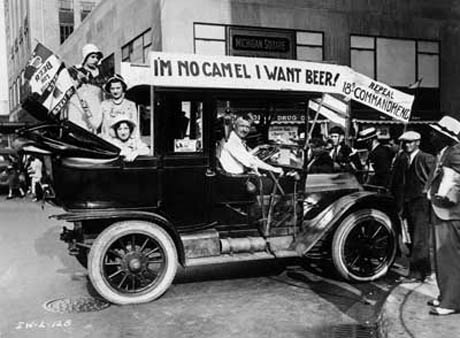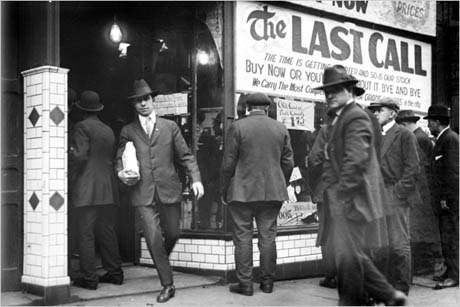Sustainability In The Brewing Industry:The Rise, Demise, and Resurgence of the Craft Brewery in America, Part II
By Jen Sotolongo
The Industrial Revolution led to great advancements in technology, machinery, generated jobs, expanded the transportation network, and created a class of very wealthy individuals. However, working conditions were often dangerous and workers had few rights in terms of hours, pay, and security.
The negative impacts of the Industrial Revolution led to a drinking problem among Americans. Alcohol abuse was blamed for societal ills, paving the road for the inevitable Prohibition. By the time the Volstead Act was signed on January 16, 1920, a number of states had already enacted prohibition laws.
On March 23, 1933, after 13 long years, President Franklin Delano Roosevelt signed into law legislation permitting the sale of 3.2% beer, effective April 7 of that year. Anxious beer drinkers, thirsty for a pint, lined the streets to celebrate the repeal of Prohibition and toast the president at the stroke of 12:01 AM. Unfortunately, an accidental omission of the words “and beer” from the bill legalizing home winemaking meant that home brewing remained illegal, and would remain so for many years.
Within a year, 756 breweries set up shop, yet the larger breweries continued to expand thanks to new technologies and marketing campaigns that left smaller breweries struggling to keep up with the competition.
Those 756 breweries dwindled to 407 in 1950 and 230 in 1961. By1983, only 80 breweries remained, operated by 51 companies. By the late-1970s, light lagers dominated store shelves, rendering the traditions and styles brought over from immigrants a distant memory. American beer drinkers had developed a taste for similarly-tasting, light lagers, thanks to successful marketing campaigns by mass beer producers.
At the same time that big brewing companies were raking in the bucks, a revolution began to take place. Despite the illegality of the activity, people began to homebrew. They craved the variety of styles of beer that were once plentiful, and if they had to break the law to quench their thirst, then so be it.
Two important events happened in California in 1965 and 1976. First, Fritz Maytag purchased 51% of Anchor Brewing after learning that his beloved brewery was set to close its doors (if you haven’t read the history of the brewery, take a few moments to do so. Anchor has overcome multiple hardships in its long history). Then, in 1976, Jack McAuliffe opened New Albion Brewery after discovering quality beer during a trip to Scotland. Though the brewery only lived a short six years, it made a great impact on the brewing community.
In 1979, President Carter lifted the ban on home brewing. The trend became so popular that further legal restrictions were lifted that encouraged the establishment of small brewing businesses and direct sales to customers (O’Brien). Home brewers, at long last, could share their creations with their communities. As demand continued to grow, the traditions long associated with beer – localism, community, celebration, creativity, and passion – began to take hold once again.
The craft brewing scene exploded during the 1990s, with annual volume growth increasing from 35% in 1991, growing annually to a high of 58% in 1995. After slowing a bit, the scene grew once more beginning in 2004, rising 6-12% annually through 2008. In 2011, annual volume totaled 13% and 1,989 breweries called the United States home, the highest number since the 1880s.
The uprising of the craft brewing culture in the United States has earned the country the title of the most diverse brewing culture in the world. Christopher O’Brien author of Fermenting Revolution suggests that “the movement was led by people who love the craft and culture of beer in its own right, rather than by corporations pursuing a fat margin.” The rebellious home brewers of the 1960s and 1970s proved that if we don’t like the way things are going, we have the power to create change.




Incredible story, non of which I had known about, and very well written. Thanks for sharing the history. Where do you think this trend is going? At what point will breweries saturate the market and start their own competitive decline?
God bless those crazy home brewers and the American brewing movement. My favorite beers — and there are a lot of them — are all from small, craft breweries. This was a great story and I loved reading it.
To kind of lead into Erin’s question, I’m wondering if the next extension is micropubs. For example, out here in Yakima we have no brewpubs like in Portland or Seattle, but we do have a few excellent micropubs. It’s all economics. It’s what folks who drink good beer can afford. And when you couple this with the burgeoning “pop-up” trend in restaurants, stores, etc., it kind of makes sense (although local liquor laws would probably make it tricky.)
Keep up the good work!
Great article Jen! I had no idea that President Carter lifted the ban on home brewing. Interesting. I have to wonder the same question that Erin posed in her post. At what point does it become too much and microbrews /breweries are a dime a dozen? What does that number look like?